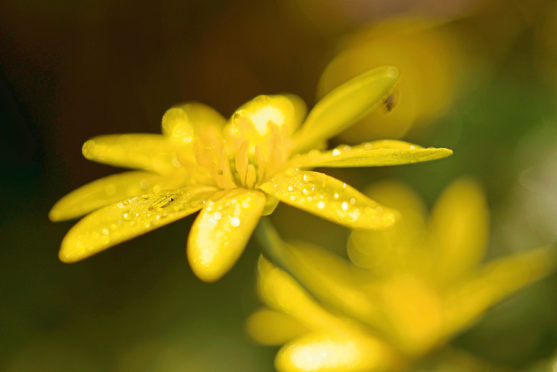Discovering golden-jewelled lesser celandines scattered across a woodland floor is one of the true pleasures of spring.
On bright sunny mornings, like little orbs of joyous sunshine, their glistening lemony petals unfurl in an enthusiastic welcoming. They are lifters of the soul and provide live giving nectar for queen bumblebees as they emerge from hibernation.
The flowers of lesser celandines are forever on the move, for they have an intriguing dynamic edge, closing when the weather is cold and wet, and opening once more when the sun shines. They do so for a purpose – dry pollen is much easier for insects to transfer and closing the petals helps prevent dampness within the flower.
In the past, lesser celandines were regarded as useful weather forecasters because they closed their petals prior to rainfall.
The plant was once known as ‘pilewort’ because of its reputed properties as an effective remedy for haemorrhoids. Apparently, the knobbly root apparently bears a strong resemblance to the appearance of piles and there was the popular belief that a plant would be effective for treating medical conditions to which it bore some resemblance. The leaves are also high in vitamin C and in the past were used to prevent scurvy.
The name ‘celandine’ derives from the Greek name for the swallow – chelidon – and the flower is perhaps so-called because it is a herald to when the first swallows arrive upon our shores.
There are other flowering gems now emerging, most noticeably wood anemones, which thrive in the dappled woodland shade. Bizarrely, their seeds are rarely fertile and wood anemones spread incredibly slowly by means of the creeping growth of their root structures – perhaps no more than six feet of gain every hundred years. As such, they are reliable indicators of ancient woodland, and are tied to traditional, long-established sites.
Indeed, it is not unusual to find wood anemones growing on open hillsides and glens miles from any trees – a sure sign that at one time such areas were forested.
The name anemone is derived from Greek which means ‘windflower’. It is a most appropriate name, for when the wind blows, its white petals quiver and shake in quite delightful fashion.
In Greek mythology, anemone flowers sprang up where Aphrodite’s tears fell as she wept over the death of her lover, Adonis. The Romans considered wood anemones a lucky charm and would pick the first flowers to appear each year to ward off fever.
Other folklore connects the wood anemone to magical fairies, who were believed to sleep within their petals after they closed at sunset.
Wood anemones and lesser celandines have inspired humankind from the earliest of times – and they continue to do so to this day. The nineteenth-century poet John Clare wrote of wood anemones as being “weeping flowers in thousands pearled in dew”. A perfect description for such perfect flowers.
INFO
Look out for primroses too over the coming weeks, with their startling yellow flowers. The name derives from prima rosa – the first rose or flower of the year, and which for generations have been picked as Easter decorations.










